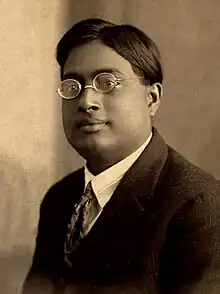1894 in science
The year 1894 in science and technology involved some significant events, listed below.
| |||
|---|---|---|---|
|
| 1894 in science |
|---|
| Fields |
| Technology |
| Social sciences |
|
| Paleontology |
| Extraterrestrial environment |
|
|
| Terrestrial environment |
|
|
| Other/related |
Astronomy
Biology
- Patrick Manson develops the thesis that malaria is spread by mosquitoes.
- Jean Pierre Mégnin publishes La faune des cadavres application de l'entomologie à la médecine légale in Paris, an important text in forensic entomology.[1]
Chemistry
- Argon identified by Lord Rayleigh and Sir William Ramsay.[2][3]
- Viscose, a form of artificial silk or rayon, is patented by Charles Frederick Cross with Edward John Bevan and Clayton Beadle.
Physiology and medicine
- Otto Binswanger describes what will become known as Binswanger's disease.
Psychology
- Psychological Review established in the United States by James Mark Baldwin and James McKeen Cattell.
Technology
- August 13 – The first Allan truss bridge, designed by Percy Allan, is completed in New South Wales.[4]
- August 14 – Oliver Lodge demonstrates "Hertzian waves" i.e. radio transmission (of Morse code) in the University of Oxford from the Clarendon Laboratory to the University Museum (200 ft; 61 m) for the British Association for the Advancement of Science[5] using a modified Branly coherer.
- November 6 – William C. Hooker of Abingdon, Illinois is granted a United States patent for a spring-loaded mousetrap.[6]
- Construction of the first oil-engined rail locomotive, an experimental unit designed by William Dent Priestman and built by his company, Priestman Brothers of Hull, England.[7]
- John Joly of Dublin devises the Joly colour screen, an additive colour photographic process for producing images from a single photographic plate.[8]
- Astronomical photographer Julius Scheiner devises a film speed measurement system.
Awards
- Copley Medal: Edward Frankland[9]
- Wollaston Medal for Geology: Karl von Zittel
Births

Born January 1: Satyendra Nath Bose
- January 1 – S. N. Bose (died 1974), Indian physicist.
- January 13 – Dorothée Pullinger (died 1986), French-born British production engineer.
- February 11 – Izaak Kolthoff (died 1993), Dutch 'father of analytical chemistry'.
- February 16 – Constance Tipper, née Elam (died 1995), English metallurgist.
- April 29 – Marietta Blau (died 1970), Austrian physicist.[10]
- May 5 – August Dvorak (died 1975), American educational psychologist.
- June 13 – Leo Kanner (died 1981), Austrian-born clinical child psychiatrist.
- June 14 – W. W. E. Ross (died 1966), Canadian geophysicist and poet.
- June 23 – Alfred Kinsey (died 1956), American biologist, professor of entomology and zoology, and sexologist, founder of the Institute for Sex Research at Indiana University (Bloomington) in 1947.
- July 8 – Pyotr Kapitsa (died 1984), Russian physicist, Nobel Prize laureate.
- July 17 – Georges Lemaître (died 1966), Belgian physicist.
- August 2 – Bertha Lutz (died 1976), Brazilian herpetologist and women's rights campaigner.
- November 19 – Heinz Hopf (died 1971), German mathematician.
Deaths

Died January 1: Hermann von Helmholtz
- January 1 – Heinrich Hertz (born 1857), German physicist.
- February 3 – Edmond Frémy (born 1814), French chemist.
- March 29 – Georges Pouchet (born 1833), French comparative anatomist.
- April 2 – Charles-Édouard Brown-Séquard (born 1817), Mauritian-born physiologist and neurologist.
- April 9 – Arthur Hill Hassall (born 1817), English physician, microbiologist and chemical analyst.
- April 27 – Birdsill Holly (born 1820), American hydraulic engineer.
- November 26 – Pafnuty Chebyshev (born 1821), Russian mathematician.
- October 7 – Oliver Wendell Holmes Sr. (born 1809), American physician and writer.
- September 8 – Hermann von Helmholtz (born 1821), German physicist.
References
- Benecke, Mark (2001). "A brief history of forensic entomology". Forensic Science International. 120 (1–2): 2–14. doi:10.1016/S0379-0738(01)00409-1. PMID 11457602.
- Rayleigh, Lord; Ramsay, William (May 1894). "Argon, a New Constituent of the Atmosphere". Proceedings of the Royal Society. London. 57 (1): 265–287. doi:10.1098/rspl.1894.0149. JSTOR 115394.
- Emsley, John (2001). Nature's Building Blocks: an A–Z Guide to the Elements. Oxford University Press. pp. 35–36. ISBN 978-0-19-850340-8.
- "Timber Truss Bridges" (PDF). McMillan Britton & Kell Pty Limited. Roads and Traffic Authority. December 1998. Retrieved 2011-06-17.
- Display in University Museum.
-
- 528671. "Animal-Trap". Google Patents. Retrieved 2012-10-01.
- Webb, Brian (1973). The British Internal Combustion Locomotive 1894–1940. Newton Abbot: David & Charles. ISBN 978-0-7153-6115-3.
- Hirsch, Robert (2005). Exploring Colour Photography: A Complete Guide (new ed.). London: Laurence King Publishing. pp. 29–30. ISBN 978-1-85669-420-9.
- "Copley Medal | British scientific award". Encyclopedia Britannica. Retrieved 23 July 2020.
- Halpen, Leopold E. (1997). "Marietta Blau". In Rayner-Canham, Marelene F.; Rayner-Canham, Geoffrey (eds.). A Devotion to Their Science: Pioneer Women of Radioactivity. Montréal: McGill-Queen's University Press. p. 196. ISBN 978-0-77351-642-7.
This article is issued from Wikipedia. The text is licensed under Creative Commons - Attribution - Sharealike. Additional terms may apply for the media files.